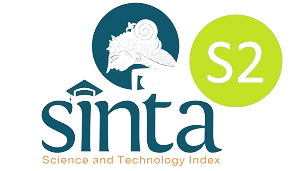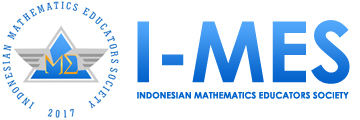Microlearning-based media of probability: An innovative student worksheet
DOI:
https://doi.org/10.29408/jel.v11i2.27600Keywords:
design research, microlearning media, probability, reasoning abilityAbstract
The constraint on reasoning ability among Indonesian mathematics students is a pressing issue. Several study results show that students' low mathematical reasoning is due to a lack of conceptual understanding of the material being studied. Probability is one of the materials that can help mathematical reasoning. There is a sample space that requires students' reasoning ability to determine all possible outcomes. This study aims to design a microlearning-based learning on probability material using the culinary tourism context of Prabumulih City that is integrated into student worksheet, which is valid and practical to help students learn the probability in phase E and train their reasoning skills by PMRI (Indonesian Realistic Mathematics Education). This study was a qualitative method of development study type, consisting of two stages: preliminary study and formative evaluation. The subject of this study was 36 tenth-grade. The data collection techniques were observation, tests, and interviews, which were analyzed descriptively. This research produced a student worksheet that was valid and practical and integrated with microlearning media (comic, video) on probability material using the culinary tourism context of Prabumulih City, Indonesia. Based on data analysis, this worksheet can improve students' conceptual understanding and reasoning abilities.
References
Aldosemani, T. I. (2019). Microlearning for macro-outcomes: students’ perceptions of telegram as a microlearning tool. In Lecture Notes in Educational Technology. Springer Singapore. https://doi.org/10.1007/978-981-13-7361-9_13
Arifin, S., Zulkardi, Putri, R.I.I., & Hartono, Y. (2021). On creativity through mathematization in solving non-routine problems. Journal on Mathematics Education, 12(2), 313-330. http://doi.org/10.22342/jme.12.2.13885.313-330
Armiati, Fauzan, A., Harisman, Y., & Sya’Bani, F. (2022). Local instructional theory of probability topics based on realistic mathematics education for eight-grade students. Journal on Mathematics Education, 13(4), 703–722. https://doi.org/10.22342/jme.v13i4.pp703-722
Astuti, D., Anggraeni, L., & Setyawan, F. (2020). Mathematical probability: Student’s misconception in higher education. Journal of Physics: Conference Series, 1613(1), 012009. https://doi.org/10.1088/1742-6596/1613/1/012009
BSKAP. (2024). Capaian pembelajaran mata pelajaran matematika fase A –fase F [Mathematics subject learning outcomes phase A - F]. Ministry of Education, Culture, Research, and Technology of the Republic of Indonesia.
Chu, Y. L. L., & Toh, T. L. (2020). A framework for designing mathematics instruction using comics at the primary school level. Journal of Research and Advances in Mathematics Education, 5(3), 218-230. https://doi.org/10.23917/jramathedu.v5i3.11373
Dolasinski, M. J., & Reynolds, J. (2020). Microlearning: A new learning model. Journal of Hospitality and Tourism Research, 44(3), 551–561. https://doi.org/10.1177/1096348020901579
Greenwood, D., Woolley, S., Goodman, J., & Vaughan, J. (2011). Essential mathematics for the Australian curricullum year 9. Cambridge University Press.
Grove, M. (2018). Math in focus mathematics extention 1. Nelson.
Hiltrimartin, C., Hartono, Y., & Indaryanti, I. (2022). Development of student activities in algebra based on problem solving in middle school. Proceedings of the 2nd National Conference on Mathematics Education 2021 (NaCoME 2021), 656(NaCoME 2021), 47–55. https://doi.org/10.2991/assehr.k.220403.008
Islamiya, I., Iriani, D., & Jambi, U. (2024). Pengembangan buku saku matematika berbasis augmented reality menggunakan PBL untuk meningkatkan kemampuan literasi matematis [Development of augmented reality based mathematics pocket book using PBL to improve mathematical literacy skills. Jurnal Ilmiah Matematika Realistik (JI-MR), 5(1), 90.
Malalina, Indra Putri, R. I., Zulkardi, & Hartono, Y. (2024). Developing mathematics teaching materials using maritime context for higher-order thinking in junior high school. Journal on Mathematics Education, 15(1), 173–190. https://doi.org/10.22342/jme.v15i1.pp173-190
Martatiyana, D. R., Derlis, A., Aviarizki, H. W., Jurdil, R. R., Andayani, T., & Hidayat, O. S. (2023). Analisis komparasi implementasi kurikulum merdeka dan Kurikulum 2013 [Comparative analysis of the implementation of the merdeka curriculum and the 2013 curriculum]. Muallimuna : Jurnal Madrasah Ibtidaiyah, 9(1), 96. https://doi.org/10.31602/muallimuna.v9i1.11600
McNeill, L., & Fitch, D. (2023). Microlearning through the lens of Gagne’s nine events of instruction: A qualitative study. TechTrends, 67(3), 521–533. https://doi.org/10.1007/s11528-022-00805-x
Nowak, G., Speed, O., & Vuk, J. (2023). Microlearning activities improve student comprehension of difficult concepts and performance in a biochemistry course. Currents in Pharmacy Teaching and Learning, 15(1), 69–78. https://doi.org/10.1016/j.cptl.2023.02.010
OECD (2023), PISA 2022 Results (Volume I): The state of learning and equity in education. OECD Publishing. https://doi.org/10.1787/53f23881-en
Samarawickrama, C., Lenadora, D., Ranathunge, R., De Silva, Y., Perera, I., & Welivita, K. (2023). Comic based learning for students with visual impairments. International Journal of Disability, Development and Education, 70(5), 769–787. https://doi.org/10.1080/1034912X.2021.1916893
Sari, D. L., Fitriani, D. A., Khaeriyah, D. Z., Hartono, & Nursyahidah, F. (2022). Hypothetical learning trajectory pada materi peluang: Konteks mainan tradisional ular naga [Hypothetical learning trajectory on the topic of probability: The context of the traditional dragon snake toy. Mosharafa: Jurnal Pendidikan Matematika, 11(2), 203–214.. https://doi.org/10.31980/mosharafa.v11i2.699
Saleh, M., Prahmana, R. C. I., & Isa, M. (2018). Improving the reasoning ability of elementary school student through the Indonesian realistic mathematics education. Journal on Mathematics Education, 9(1), 41-54.
Shomad, M. A., & Rahayu, S. (2022). Efektivitas komik sebagai media pembelajaran matematika [The effectiveness of comics as a medium for learning mathematics]. Journal of Techonolgy Mathematics and Social Science), 2(2), 2829–3363.
Suharsono, A., Mashuri, M., Wibawati, W., Khusna, H., & Ahsan, M. (2023). Pelatihan pembelajaran statistika untuk peningkatan kompetensi guru matematika di Kabupaten Sumenep [Statistics learning training to improve mathematics teacher competency in Sumenep regency]. Sewagati, 7(5), 672–681. https://doi.org/10.12962/j26139960.v7i5.542
Sutarni, S., Sutama, S., Prayitno, H. J., Sutopo, A., & Laksmiwati, P. A. (2024). The development of realistic mathematics education-based student worksheets to enhance higher-order thinking skills and mathematical ability.Infinity, 13(2), 285-300. https://doi.org/10.22460/infinity.v13i2.p285-300
Tanzimah, & Sutrianti, D. (2023). Analisis kesalahan siswa dalam menyelesaikan soal cerita pada materi peluang berdasarkan prosedur Newman’s Error Analysis (NEA) [Analysis students' errors in solving story problems on probability material based on Newman's Error Analysis (NEA)] . Jurnal Inovasi Pendidikan Matematika, 5(2), 191–200.
Tessmer M. (1993). Planning and conducting formative evaluation. Kogan Page.
Ulfah, A. S., Yerizon, Y., & Arnawa, I. M. (2020, May). Preliminary research of mathematics learning device development based on realistic mathematics education (RME). Journal of Physics: Conference Series, 1554(1), 012027. https://doi.org/10.1088/1742-6596/1554/1/012027
Waheed, H., Hassan, S. U., Nawaz, R., Aljohani, N. R., Chen, G., & Gasevic, D. (2023). Early prediction of learners at risk in self-paced education: A neural network approach. Expert Systems with Applications, 213(PA), 118868. https://doi.org/10.1016/j.eswa.2022.118868
Wardani, D. A. W. (2023). Problem based learning: membuka peluang kolaborasi dan pengembangan skill siswa [opening up opportunities for collaboration and students' skill development]. Jawa Dwipa, 4(1), 1-17.
Wijaya, A., Elmaini, & Doorman, M. (2021). A learning trajectory for probability: A case of game-based learning. Journal on Mathematics Education, 12(1), 1–16. https://doi.org/10.22342/JME.12.1.12836.1-16
Zulkardi, Putri, R. I. indra, & Wijaya, A. (2020). Two decades of realistic mathematics education in Indonesia. https://doi.org/10.1007/978-3-030-20223-1_18
Zulkardi, Z., & Putri, R. I. I. (2020). Supporting mathematics teachers to develop jumping task using PISA framework (JUMPISA). Jurnal Pendidikan Matematika, 14(2), 199–210. https://doi.org/10.22342/jpm.14.2.12115.199-210
Downloads
Published
How to Cite
Issue
Section
License
Copyright (c) 2025 Novi Komariyatiningsih, Yusuf Hartono, Ratu Ilma Indra Putri, Cecil Hiltrimartin

This work is licensed under a Creative Commons Attribution-ShareAlike 4.0 International License.
Authors who publish with the Jurnal Elemen agree to the following terms:
- Authors retain copyright and grant the journal right of first publication with the work simultaneously licensed under Creative Commons Attribution-ShareAlike 4.0 International License (CC BY-SA 4.0).
- Authors are able to enter into separate, additional contractual arrangements for the distribution of the journal's published version of the work (e.g., post it to an institutional repository or publish it in a book), with an acknowledgment of its initial publication in this journal.
- Authors are permitted and encouraged to post their work online (e.g., in institutional repositories or on their website) prior to and during the submission process, as it can lead to productive exchanges, as well as earlier and greater citation of published work.
Jurnal Elemen is licensed under a Creative Commons Attribution-ShareAlike 4.0 International License





